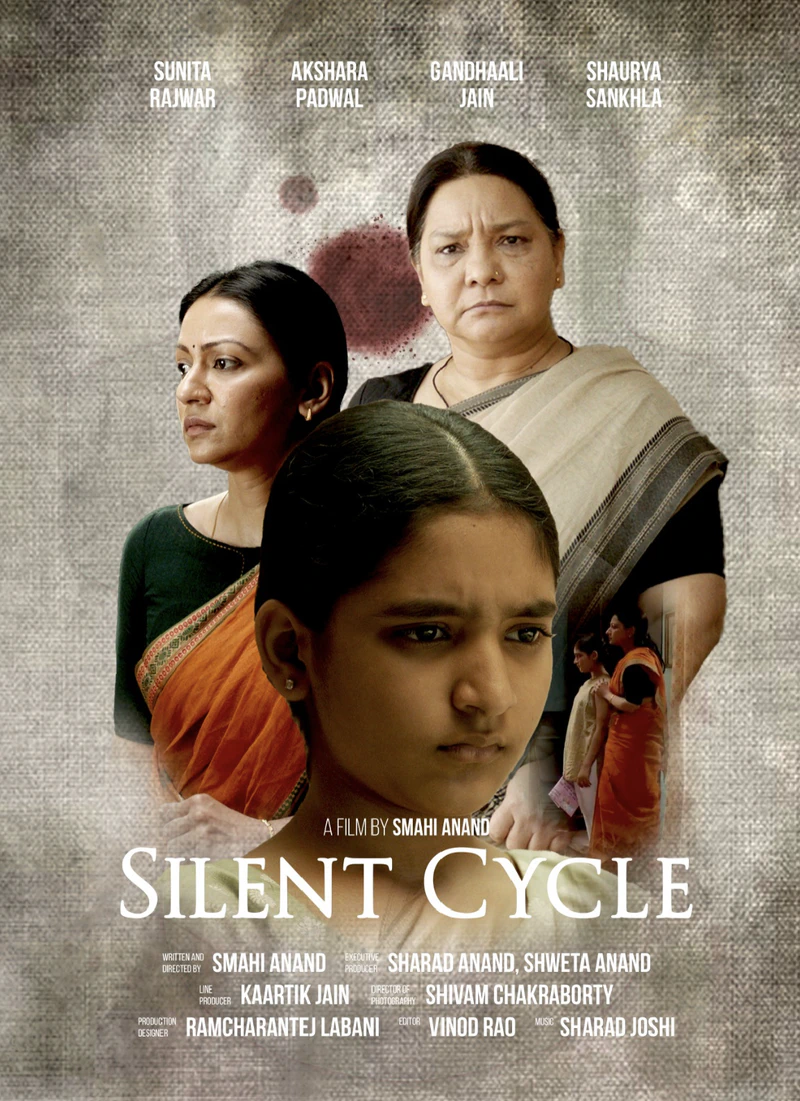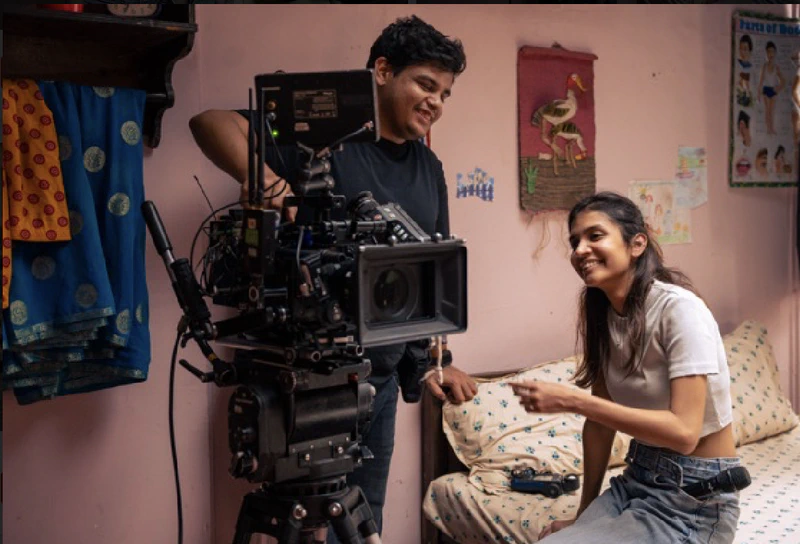Originally from Noida, Uttar Pradesh, Smahi Anand is now based in Los Angeles after earning her BFA in Film from the New York Film Academy. Through her short film Silent Cycle, tells a story about menstruation and the cultural taboos surrounding it in India. Anand draws from her own experiences to craft a story that addresses a topic still shrouded in secrecy for many.
In an exclusive chat, she shares insights into her journey, the making of Silent Cycle, and the impact she hopes to create.
 Smahi in the sets of Silent Cycle
Smahi in the sets of Silent CycleTell us about your growing up years.
Growing up, my childhood was a blend of creativity and curiosity. I was surrounded by stories through books, paintings, and films. Bollywood in particular sparked my imagination, and I was captivated by its larger-than-life characters and vibrant storytelling. Art played a significant role in my life as well, laying the foundation for my love for visual storytelling through film. My father, who worked in the film industry before joining the family business, was a pivotal influence in shaping my interest in cinema.
What inspired you to make Silent Cycle?
Silent Cycle was born from my own experiences growing up and the confusion I felt about the unspoken rules surrounding menstruation. I questioned why there was so much secrecy around something so natural. These experiences stayed with me, fueling a desire to challenge the silence and shame that still surrounds menstruation in many communities. While I was fortunate to be educated about menstrual hygiene, I know that many women in India continue to rely on outdated practices, like using old cloth. Through this film, I aim to bring these stories to light and foster an open dialogue about menstruation and its impact, particularly on young girls.
Another challenge was engaging male viewers, who might initially see the subject as irrelevant to them
How did you approach the sensitive subject of menstruation in your film?
Approaching the topic of menstruation required a blend of empathy, authenticity, and a commitment to breaking taboos. I grounded the story in real experiences, both mine and those shared with me by other women. I wanted to portray menstruation as more than just a biological process—it’s an experience that shapes lives in profound ways. I focused on the intergenerational relationship between Vrinda and her grandmother, Lata, to explore how cultural traditions and beliefs are passed down. The film uses symbolism and visual metaphors to convey the weight of these inherited beliefs while avoiding sensationalism. My goal was to create a visually engaging, emotionally resonant film that sparks conversations about menstrual health and stigma.
What challenges did you face in portraying such a topic authentically without alienating any segment of the audience?
One of the biggest challenges was avoiding the reinforcement of stereotypes while ensuring that the film didn’t alienate any viewers. I wanted to depict menstruation in a way that was relatable and respectful. This required careful attention to character development and dialogue. Another challenge was engaging male viewers, who might initially see the subject as irrelevant to them. By portraying the impact of menstruation on families and communities, not just on women, I hoped to foster empathy and understanding. Ultimately, the film’s themes are universal—growth, self-acceptance, and breaking free from inherited beliefs—which resonate with all audiences.
 Poster of Silent Cycle
Poster of Silent CycleWhat was the most difficult scene to shoot in Silent Cycle?
The most difficult scene was during the Navratri puja when Vrinda’s first menstruation is discovered. Her brother, Jai, notices a blood spot on her dress, and her grandmother, Lata, reacts with anger, believing Vrinda has committed a sin in a holy place. This scene required a delicate balance between Lata’s emotional outburst and Vrinda’s innocent confusion. Directing the young actress to express fear and bewilderment was challenging. Additionally, it was important to handle the cultural sensitivity of this scene with respect, as Navratri is a significant festival, and I didn’t want to alienate viewers who hold these traditions dear.
How did you ensure that the message was conveyed clearly and sensitively?
I focused on authenticity and cultural awareness in both the direction and storytelling. The characters were developed to be multi-dimensional, allowing their emotional responses and cultural contexts to drive the narrative. I used visual metaphors and subtle imagery to convey the film’s emotional weight. Cultural consultation played a key role, as I engaged with individuals who had firsthand experience with these themes to ensure accuracy and sensitivity. Feedback from test audiences also helped refine the portrayal, ensuring the film’s message was received as intended.
Films like Silent Cycle play a pivotal role in breaking taboos by presenting menstruation as a natural, everyday experience
How do you think Silent Cycle will impact audiences?
I hope Silent Cycle encourages viewers to confront and question the taboos surrounding menstruation. By telling Vrinda’s story, I aim to foster empathy and understanding, especially around the challenges faced by young girls navigating cultural expectations. The film educates viewers about menstrual health and hygiene, particularly in contexts where access to information may be limited. Ultimately, I want to inspire conversations that break the silence around menstruation, promoting more inclusive and progressive attitudes toward women’s health.
 A behind the scenes still from the shoot of Silent Cycle
A behind the scenes still from the shoot of Silent CycleWhat kind of change or awareness are you hoping to inspire in viewers?
I hope to normalize menstruation as a natural part of life and encourage open conversations about it. I want viewers to question cultural beliefs that perpetuate shame and secrecy around menstruation. By showcasing the emotional and psychological impact of menstruation, especially on young girls, I hope to inspire empathy and foster a supportive environment for discussions on women’s health. Ultimately, I want to empower individuals to embrace their experiences with confidence and pride, free from societal constraints.
Did you face any resistance while making this film?
Addressing menstruation in a culture where it is still considered taboo presented its challenges. Some actors were hesitant to participate, fearing the subject’s controversial nature. There were also concerns about how the film would be received by traditional audiences. Overcoming this resistance required open conversations about the film’s message and potential impact. It was essential to handle the subject matter with care, ensuring it was portrayed with the utmost sensitivity and respect.
Were there any cultural or societal barriers you had to overcome during production?
Yes, there were significant cultural barriers, particularly around the secrecy and stigma associated with menstruation. Navigating these societal expectations was a challenge, but it was crucial to balance respect for tradition with the need to push boundaries and create change. The resistance to discussing menstruation openly made it harder to find support and resources during production. However, overcoming these barriers was essential in ensuring that Silent Cycle could spark meaningful dialogue and challenge societal norms.
 A still from the short film
A still from the short filmMenstruation remains a taboo topic in many parts of India. How do you believe films like Silent Cycle can contribute to breaking these taboos and fostering open dialogue?
Films like Silent Cycle play a pivotal role in breaking taboos by presenting menstruation as a natural, everyday experience. They challenge long-standing stigmas and encourage audiences to engage in discussions without discomfort or shame. By portraying menstruation authentically, the film fosters empathy and understanding, prompting viewers to question cultural norms and adopt more progressive attitudes. Silent Cycle also aims to educate audiences about menstrual health and hygiene, empowering them with knowledge and promoting better practices.






